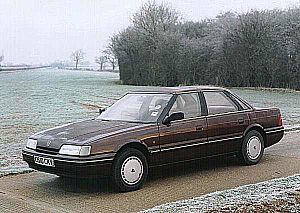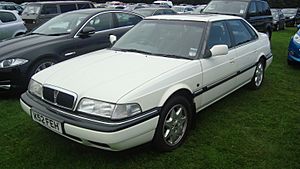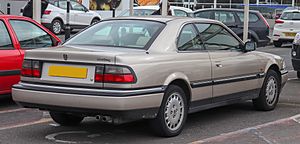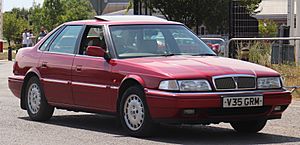Rover 800 series facts for kids
Quick facts for kids Rover 800 Series |
|
|---|---|
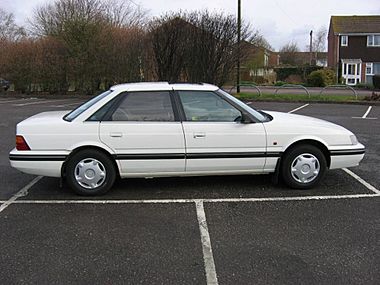
1990 Mk1 Rover 820i Saloon
|
|
| Overview | |
| Manufacturer | Austin Rover Group (1986-88) Rover Group (1988-98) |
| Also called | Rover 820 Rover 825 Rover 827 Rover Sterling Rover Vitesse Sterling 825 |
| Production | 1986–1999 |
| Designer | Gordon Sked (1983) |
| Body and chassis | |
| Class | Executive car (E) |
| Layout | Transverse FF layout |
| Related | Honda Legend (1st gen.) Acura Legend (1st gen.) |
| Chronology | |
| Predecessor | Rover SD1 |
| Successor | Rover 75 |
The Rover 800 series was a type of fancy, larger car, known as an executive car. It was made by the Austin Rover Group and later the Rover Group from 1986 to 1999. In the United States, it was sold as the Sterling.
This car was created with help from Honda, a famous Japanese car company. It was very similar to the Honda Legend and took over from the older Rover SD1 model.
Contents
How the Rover 800 Was Made
Working with Honda
The Rover 800 series came about because two big car companies, British Leyland (BL) and Honda, decided to work together. Their first joint car was the Triumph Acclaim. After that, they looked for more projects to team up on.
Both companies needed a new, large, luxury car. BL needed a replacement for its Rover SD1. Honda wanted to sell more cars in the big North American market. To do this, they needed a larger, more luxurious car than their Honda Accord.
So, in 1981, they started designing a new car together. Rover called their project "XX," and Honda called theirs "HX" (which became the Honda Legend). They worked on the design at Rover's factory in Cowley, England, and at Honda's center in Japan.
The cars shared the same basic structure and floor. But they had different looks on the outside and different interiors. Honda provided the powerful V6 petrol engine, the automatic and manual gearboxes, and the car's main design. Rover provided the 4-cylinder petrol engine and many of the electrical parts.
Honda and Austin Rover also agreed that some Honda Legend cars would be built at Rover's Cowley factory for the British market. Cars for the US market were made in Japan. The Rover 800 was officially launched on July 10, 1986.
Mark I: The First Version (1986-1991)
| Mark I | |
|---|---|
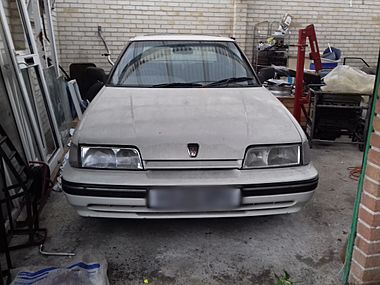
Frontend of a 1990 pre-facelift Rover 820i.
|
|
| Overview | |
| Manufacturer | Austin Rover Group (1986-88) Rover Group (1988-91) |
| Production | 1986–1991 |
| Assembly | Cowley, Oxford, England |
| Body and chassis | |
| Body style | 4-door saloon 5-door fastback/hatchback |
| Powertrain | |
| Engine | PETROL: - Rover 2.0L L4 8v (O-series) - Rover 2.0L L4 16V (M-series) - Rover 2.0L L4 16V Turbo (T-series) - Honda 2.5L V6 24V (C25A) - Honda 2.7L V6 24V (C27A) |
| Transmission | 5-speed manual 4-speed automatic |
| Dimensions | |
| Wheelbase | 2,760 mm (108.7 in) |
| Length | 4,694 mm (184.8 in) |
| Width | 1,946 mm (76.6 in) |
| Height | 1,398 mm (55.0 in) |
When the Rover 800 first came out, the 2-liter versions used a special 16-valve engine from British Leyland. The more powerful 2.5-liter versions used a V6 engine designed by Honda. At first, only a four-door saloon (a car with a separate trunk) was available. A five-door liftback (a car with a sloped rear that opens like a hatchback) came out in 1988.
Unlike earlier large Rover cars, the 800 series did not have a V8 engine. Also, it was a front-wheel-drive car, meaning the engine powered the front wheels. This was different from its predecessor, the SD1, which was rear-wheel drive.
Later, in 1990, a diesel version of the car was introduced. It used a 2.5-liter engine from an Italian company called VM Motori.
The "Sterling" name was used for the most luxurious saloon version in Europe and other markets. The "Vitesse" name was for the sportier fastback model. These top models usually had the V6 engine.
In the USA, the car was called the Sterling and only came with the Honda V6 petrol engines. Sales started strong, but soon people found problems with how the cars were built. Things like the interior trim, electrical parts, and paintwork had issues. This was a big problem because the similar Acura Legend (Honda's luxury brand) was doing very well in America at the same time.
Even with problems in America, the Rover 800 was the best-selling executive car in the UK for eight years! In 1988, the 2.5-liter engine was made bigger to 2.7 liters, and the car's quality got much better.
The original Rover 800 was very popular in Britain. It competed with cars like the Ford Granada/Scorpio and Vauxhall Carlton.
Mark II: The Big Update (1991-1999)
| Mark II | |
|---|---|
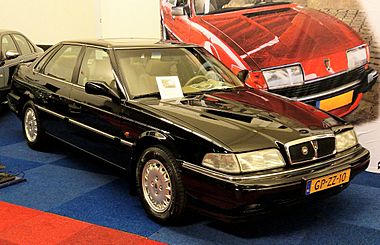
Rover 800 Saloon (after the big update)
|
|
| Overview | |
| Manufacturer | Rover Group |
| Production | 1991–1999 |
| Assembly | Cowley, Oxford, England |
| Body and chassis | |
| Body style | 4-door saloon 5-door fastback/hatchback 2-door coupé |
| Powertrain | |
| Engine | PETROL: - Rover 2.0L L4 16V (T-series) - Rover 2.0L L4 16V Turbo (T-series) - Rover 2.5L V6 24V (KV6) - Honda 2.7L V6 24V (C27A) DIESEL: - VM Motori 2.5L L4 8v Turbo (425 OHV) |
| Transmission | 5-speed manual 4-speed automatic |
| Dimensions | |
| Wheelbase | 2,760 mm (108.7 in) |
| Length | 4,882 mm (192.2 in) |
| Width | 1,965 mm (77.4 in) (Saloon & Fastback) 1,900 mm (74.8 in) (Coupé) |
| Height | 1,363 mm (53.7 in) (Saloon & Fastback) 1,400 mm (55.1 in) (Coupé) |
In late 1991, the Rover 800 got a major update, known as the R17. It had a new, curvier body and brought back the classic Rover grille. This new look was very popular. The car's sales went up, and it became Britain's best-selling executive car in the early to mid-1990s. It even beat the Ford Granada.
Rover worked hard to fix the quality problems from the earlier models. The overall quality improved a lot. However, some issues like interior rattles and electrical problems still happened.
The 2.0-liter engine was updated to the T16, which came in both normal and turbocharged versions. The turbocharged version was used in the Vitesse model.
The Coupé Version
A two-door coupé version of the 800 was launched in early 1992. A coupé is a car with two doors and a sleek, sporty design. This version was originally planned for the American market, but Rover had already left the US before it came out. However, it was sold in other countries. About 80% of the Coupé's interior and exterior was finished by hand!
From 1992 to 1996, the Rover 800 Coupé came only with the 2.7 Honda V6 engine. It also had 16-inch Rover 'Prestige' wheels. It came standard with a four-speed automatic gearbox and could go over 130 miles per hour.
Small Update in 1996
In 1996, the 800 got a small update. The outside changes were minor, like painting the black strips on the car's sides. Inside, things like climate control, a special security system, and a passenger airbag became standard. A 6-disc CD changer was also added to most models. The interior also got more wood finishes and fancy pleated seats, many of which were handmade.
Even though the 800 was getting older compared to its rivals, it continued to sell steadily until the spring of 1999. It was then replaced by the Rover 75.
Common Issues
The Rover 800 series, especially with the Rover KV6 and M-series engines, sometimes had problems like head gasket failures. Rover often replaced the engines when this happened. The KV6 engine was usually paired with a JATCO gearbox, which also had some reliability issues, sometimes because of incorrect fluid changes.
The Rover 820 Vitesse, with its powerful 2-liter turbo engine, sometimes had problems with its gearbox bearings. These bearings could be replaced with stronger ones.
Model Names
Rover didn't always use a clear naming system for its cars. But here's a simple guide for the Rover 800 series:
- 820 – Had a 4-cylinder, 8-valve engine.
- 820e – Had a 4-cylinder, 16-valve engine with single point injection.
- 820i – Had a 4-cylinder, 16-valve engine with multi-point injection. This version also came with a turbocharger later.
- 825i – Early 6-cylinder models (before 1988).
- 827i – Later 6-cylinder models (after 1988) and US models.
- Sterling – The most luxurious model in most markets.
- Vitesse – The sportiest model in most markets.
After the big update in 1992, the names were simplified:
- 820i/Si/SLi/Sterling – 4-cylinder, 16-valve engines. The Vitesse model had a turbocharged version.
- 825D/SD – 4-cylinder diesel models.
- 827i/Si/SLi/Sterling – 6-cylinder models (before 1996).
- 825i/Si/SLi/Sterling – 6-cylinder models (after 1996, with the Rover KV6 engine).
- Sterling – Still the luxury flagship model.
- Vitesse – Still the sports flagship model.
Who Used the Rover 800?
The Rover 800 was a very important car for the British government. They used it as part of their official car fleet for many years. This continued a tradition of using British-made Rover and Jaguar cars. Tony Blair, who later became Prime Minister, owned an early 800 soon after it launched.
Many British police forces also used the Rover 800 as police cars. In popular culture, the fictional radio DJ Alan Partridge drives an 825 saloon in the TV show I'm Alan Partridge.
Motorsport Fun
On June 6, 1988, a driver named Tony Pond did something amazing. He completed the first-ever lap of the famous TT motorcycle course on the Isle of Man in a car! He drove a Rover 827 Vitesse at an average speed of over 99.58 miles per hour. The car was mostly standard, except for safety features and racing tires.
How Many Were Made?
The production of the Rover 800 peaked in 1987, its first full year. But by 1991, production dropped a lot because of an economic slowdown and because a new, updated model was coming out. By 1998, the number of cars made each year was much lower than in 1987.
In total, 317,306 Rover 800 cars were built.
| 1986 | 15,609 |
| 1987 | 54,434 |
| 1988 | 48,634 |
| 1989 | 35,387 |
| 1990 | 29,460 |
| 1991 (pre-facelift) | 10,007 |
| 1991 (post-facelift) | 2,961 |
| 1992 | 28,136 |
| 1993 | 28,354 |
| 1994 | 21,802 |
| 1995 | 13,311 |
| 1996 | 11,400 |
| 1997 | 11,131 |
| 1998 | 6,500 |
| 317,306 were built in total |
Images for kids
See also
 In Spanish: Rover 800 para niños
In Spanish: Rover 800 para niños


